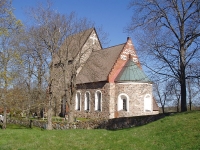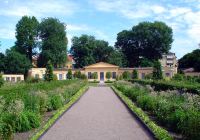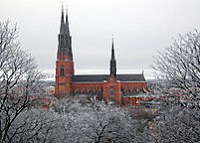
Three miles (5km) north of Uppsala, Gamla Uppsala was once an important town, the seat of Swedish royalty and the site of many historic funerals. It was an important religious and cultural centre as early as the 3rd century AD, and ancient sources identify the site as the power centre of the legendary Yngling dynasty of Swedish royalty. The Uppsala temple oversaw rites and sacrifices to the Norse gods in the pre-Christian era, and it was said that Odin himself resided there.However, as Christianity overtook Europe, the ancient temple was burned and the stone church of Gamla Uppsala was built in the 12th century. The church still stands today, along with a grave field of about 250 burial mounds. Once, between 2,000 and 3,000 ancient burial mounds could be found at Gamla Uppsala but farmlands have encroached on the archaeological treasures. Gamla Uppsala also has a small museum detailing the rich history of the town, and a few historic old buildings.Today, Gamla Uppsala has a population of under 20,000 and it is a picturesque little town, well worth a visit for its historical atmosphere and beautiful surroundings. Visitors can spend the day on a guided tour (available during the summer months). The main attractions include Gamla Uppsala Museum, Gamla Uppsala Church and the open-air museum behind it, and Odinsborg restauarant. The town is accessible from Uppsala by a quick bus trip.
E-mail : [email protected]
Website : http://www.destinationuppsala.se/en/To-do/ToDo/?tlang=en&tid=717818
Telephone : +46 18 23 93 00
Transport : Visitors can reach Gamla Uppsala by taking the 110 bus from Uppsala C.

The Linnaeus Garden was founded in 1655 as the first botanical garden in Sweden. It wasn't until the 18th century that Carl Linnaeus (also known as Carolus Linnaeus or Carl von Linne), a prominent Swedish botanist zoologist, physician, and father of modern taxonomy and ecology, redesigned the garden and began cultivating plants under his own system. It now contains roughly 1,300 plant species, and is maintained by Uppsala University. Within the garden is the Linnaeus museum, which was the scientist's home for 35 years. The garden is a living complement to Linnaeus' work; he designed the plot to demonstrate his theories to his students, choosing each plant for a purpose. Although the garden fell into a state of disrepair for more than a century, it was faithfully restored in 1917 using the detailed plant lists and garden maps of Linnaeus himself. Although in many ways the garden is an academic exercise, fascinating for people interested in subjects like phenology, it is also a beautiful botanical space in its own right and can be enjoyed for its aesthetic quality alone. Guided tours of the garden are available but must be arranged in advance by phone or email. There is a restaurant in the garden for refreshments.
Address : Svartbäcksgatan 27.
E-mail : [email protected]
Website : www.linnaeus.uu.se
Telephone : +46 18 471 28 38
Transport : Visitors can get to the gardens by city buses 2, 5, 13, 14 and 42, while regional buses 110, 111, and 115 are also suitable. All buses stop at Skolgatan, which is only a short walk from the Linnaeus Gardens.
Opening times : May: Tuesday–Sunday 11am–5pm. June–August: Monday–Sunday 11am–5pm. Closed Midsummer Eve. September: Friday–Sunday 11am–5pm
Admission : Adults pay SEK 80, while children (below 17 years of age) are admitted for free.

The tallest church in Scandinavia at 390 feet (119m), the Uppsala Cathedral, also called the Uppsala Domkyrka, dominates the city's skyline. The church was built in the 14th century for royal coronations, and is now the seat for the Archbishop for the Lutheran Church of Sweden. A number of Swedish kings and other prominent citizens are interred inside. The exterior of the cathedral is made of red brick, with a French Gothic interior featuring murals of St Erik, the patron saint of Sweden. In the summer months there are often lunch-time concerts on the tower balcony.Brochures in numerous languages are available for a small fee, but those really interested in the cathedral's history should consider hiring a guide as there is a wealth of history on display in the church for those who know what they're looking for (if you don't bring your own guide, somebody at the church will usually be available to show you around free of charge). There is also a small museum housing ecclesiastical relics, and a graveyard with elaborately-carved tombstones. The cathedral has a small gift shop and cafe. Considered by many to be the top attraction in Uppsala, and much-loved by the locals, the cathedral is a hub of activity in the community, frequently hosting events and plenty of live music.
Address : Domkyrkoplan 2, Uppsala.
Website : www.uppsaladomkyrka.se
Telephone : +46 18 430 3500

Travel Guide powered by Word Travels, copyright © 2023 Globe Media Ltd. By its very nature information in this travel guide is subject to change at short notice and travellers are urged to verify information on which they're relying with the relevant authorities. Neither Globe Media Ltd nor Travel Vogue can accept any responsibility for any loss or inconvenience to any person as a result of information contained above.